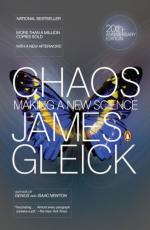
|
| Name: _________________________ | Period: ___________________ |
This test consists of 5 multiple choice questions, 5 short answer questions, and 10 short essay questions.
Multiple Choice Questions
1. What refers to a closed trajectory in phase space having the property that at least one other trajectory spirals into it either as time approaches infinity or as time approaches negative infinity?
(a) Limit-cycle.
(b) Fractal compression.
(c) Fractal basin boundaries.
(d) Period doubling bifurcation.
2. What is defined as a mess of disorder on all scales and is not stable?
(a) Turbulence.
(b) Energy.
(c) Viscosity.
(d) Fractal.
3. From what institution did Harry L. Swinney earn his Ph.D.?
(a) The University of Bonn.
(b) The University of Illinois.
(c) Caltech.
(d) Johns Hopkins University.
4. Where did Michael Barnsley earn his Ph.D.?
(a) The Massachusetts Institute of Technology.
(b) The University of Paris.
(c) Johns Hopkins University.
(d) The University of Wisconsin-Madison.
5. Where was Mitchell Feigenbaum born?
(a) Hartford, Connecticut.
(b) New York, New York.
(c) Biloxi, Mississippi.
(d) Frankfort, Kentucky.
Short Answer Questions
1. Where is Michael Barnsley from?
2. What were used to address deep issues in theoretical physics according to the author in Chapter 8, "Images of Chaos"?
3. In mathematics, what refers to a map that exhibits some sort of chaotic behavior?
4. What refers to systems whose behavior is intrinsically non-deterministic?
5. When did Albert Libchaber join the faculty at The Rockefeller University?
Short Essay Questions
1. Whose results did Albert Libchaber inadvertently recreate in Chapter 7, "The Experimenter"?
2. Who was Johann Wolfgang von Goethe? For what great work is he most well known?
3. What did Mitchell Feigenbaum determine needed to happen in Chapter 6, "Universality"? Where was he working?
4. How did Barnsley's approach differ from that of Richter and Peitgen in Chapter 8, "Images of Chaos"?
5. How does the author differentiate between theorists and experimentalists in Chapter 5, "Strange Attractors"?
6. Describe the career of Heinz-Otto Peitgen. Where is Peitgen from?
7. What is the definition of a bifurcation diagram?
8. What is the Taylor vortex flow and when does it emerge?
9. Describe the Mandelbrot set. To what it is closely related?
10. How is the Taylor-Couette flow defined?
|
This section contains 754 words (approx. 3 pages at 300 words per page) |

|




